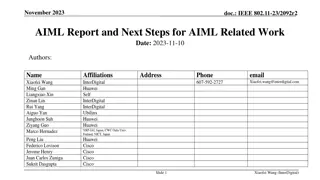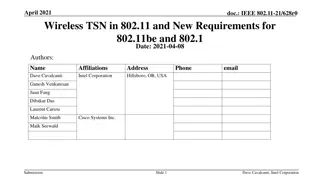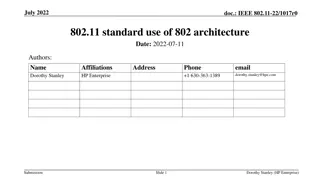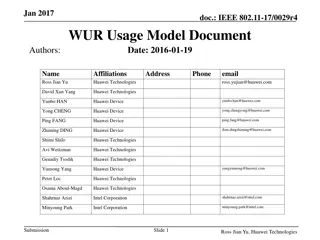IEEE 802.11-16/1465r0: Smart Home Usage Model in Nov. 2016
The document discusses the usage models for IEEE 802.11 wake-up radio in smart home environments. It outlines scenarios where low latency and power efficiency are crucial, detailing how smart devices like curtains can interact with access points using wake-up packets. The presentation emphasizes the coexistence of legacy devices with newer technologies to enable seamless communication in smart homes.
Download Presentation

Please find below an Image/Link to download the presentation.
The content on the website is provided AS IS for your information and personal use only. It may not be sold, licensed, or shared on other websites without obtaining consent from the author.If you encounter any issues during the download, it is possible that the publisher has removed the file from their server.
You are allowed to download the files provided on this website for personal or commercial use, subject to the condition that they are used lawfully. All files are the property of their respective owners.
The content on the website is provided AS IS for your information and personal use only. It may not be sold, licensed, or shared on other websites without obtaining consent from the author.
E N D
Presentation Transcript
Nov 2016 doc.: IEEE 802.11-16/1465r0 WUR Usage Model Date: 2016-11-07 Authors: Name Ross Jian Yu Affiliations Address Huawei Technologies Huawei Technologies Huawei Device Phone email ross.yujian@huawei.c om David Xun Yang yunbo.han@huawei.com Yunbo HAN yong.chengyong@huawei.co m ping.fang@huawei.com Yong CHENG Huawei Device Ping FANG Huawei Device dzm.dingzhiming@huawei.c om Zhiming DING Huawei Device Shimi Shilo Huawei Technologies Huawei Technologies Huawei Technologies Huawei Device Avi Weitzman Genadiy Tsodik Yunsong Yang Peter Loc Huawei Technologies Submission Slide 1 Ross Jian Yu, etc., Huawei Technologies
Nov 2016 doc.: IEEE 802.11-16/1465r0 Background In the PAR proposal for wake-up radio[1], several key points have been proposed: In scenarios where low latency is a requirement, the WUR should decrease overall power consumption of the STA without significant increase in impact to the latency (relative to the current maximum latency of the nominal duration of one beacon interval, 102.4 ms) in transferring user data packets. In order to enable a wider set of use cases, both AP and non-AP types of STAs can be equipped with a WUR that can receive wake-up messages. Based on the above key points, this presentation provides a number of usage models to help guide standardization effort. Submission Slide 2 Ross Jian Yu, etc., Huawei Technologies
Nov 2016 doc.: IEEE 802.11-16/1465r0 Usage Model 1: Smart Home Environment: In a house/apartment, an AP and several devices are arranged naturally from the perspective of the house/apartment occupant. Some STAs (e.g., home appliances) don t need to consider the power assumption whilst some STAs (e.g., smart-curtain, smart-door) are equipped with coin batteries which expect to last for several years. Besides, a few sensors are used to collect the information of the house. Normal 802.11 traffic data exists in the network, e.g., The server transmits video to the TV through the AP. The TV transmits video to the mobile phone. Light sensor Submission Slide 3 Ross Jian Yu, etc, Huawei Technologies
Nov 2016 doc.: IEEE 802.11-16/1465r0 Usage Model 1: Smart Home Sub-model 1: the sensor transmits the light condition to the server through the AP, which determines whether the curtain needs to be open or closed. Then the server tells the curtain the open/close command through the AP. The AP transmits a Wake-up Packet (WUP) to the WUR of the smart curtain. After the Main Radio (MR) is awake, the AP transmits a message to let the smart-curtain open/close the curtains. Light condition Message Light condition WUP to WUR, then message to MR Sub-model 1 Submission Slide 4 Ross Jian Yu, etc, Huawei Technologies
Nov 2016 doc.: IEEE 802.11-16/1465r0 Usage Model 1: Smart Home Sub-model 2: the owner of the house uses his mobile phone to tell the smart curtain that he wants to open/close the curtain through the AP. The AP transmits a WUP to the WUR of the smart curtain. After the MR is awake, the AP transmits a message to let the smart-curtain open/close the curtains. Message WUP to WUR, then message to MR Requirement: Sub-model 2 The WUP transmission should enable coexistence with legacy IEEE 802.11 devices operating in the same band. The AP should consider the case where some STAs are equipped with WURs whilst some STAs are not. Slide 5 Submission Ross Jian Yu, etc, Huawei Technologies
Nov 2016 doc.: IEEE 802.11-16/1465r0 Usage Model 2: Warehouse Environment: In a warehouse, there exists one AP. In each container/box or on each shelf, there are one or several sensors equipped with coin battery. The server will frequently collect the temperature/humidity/location from the sensors through the AP. Besides, the workers are equipped with mobile phones, and may also try to collect those information with their mobile phones through the AP. Normal 802.11 traffic data exists in the network, e.g., The server collects surveillance video from the cameras and transmit the video to the computer through the AP. Submission Slide 6 Ross Jian Yu, etc, Huawei Technologies
Nov 2016 doc.: IEEE 802.11-16/1465r0 Usage Model 2: Warehouse Sub-model 1: The server wants to request the status of one box through the AP. The AP transmits a WUP to the WUR of the sensor. After the MR is awake, the AP transmits a status query command to let the sensor feedback the status. Sub-model 2: the worker of the warehouse uses his mobile phone to request the status of one box through the AP. The AP transmits a WUP to the WUR of the sensor. After the MR is awake, the AP transmits a status query command to let the sensor feedback the status. Then the AP transmits the status to the mobile phone. Status query command Status query Status feedback WUP to WUR, then status query command to MR status feedback WUP to WUR, then status query command to MR status feedback Status feedback Box with sensor Box with sensor Sub-model 1 Sub-model 2 Submission Slide 7 Ross Jian Yu, etc, Huawei Technologies
Nov 2016 doc.: IEEE 802.11-16/1465r0 Usage Model 2: Warehouse Requirement: The WUP transmission should enable coexistence with legacy IEEE 802.11 devices operating in the same band. The system should consider the case where large number of STAs equipped with WURs exist. Submission Slide 8 Ross Jian Yu, etc, Huawei Technologies
Nov 2016 doc.: IEEE 802.11-16/1465r0 Usage Model 3: Outdoor Cattle Farms Environment: In an outdoor cattle farms, a cattle farmer uses his mobile phone as an mobile AP. Every cow is equipped with a sensor. The cattle farmer can use his mobile phone to frequently collect the temperature/location of each cow. The sensors may also transmit some emergency report to the mobile AP. Submission Slide 9 Ross Jian Yu, etc, Huawei Technologies
Nov 2016 doc.: IEEE 802.11-16/1465r0 Usage Model 3: Outdoor Cattle Farms Sub-model 1: the mobile AP transmits a WUP to the WUR of the sensors. After the MR is awake, the AP transmits a status query common to let the sensors feedback the status. Sub-model 2: when some emergency/critical event happens, the sensors will transmit a WUP to the mobile AP, when the MR of the mobile AP is awake, the sensors will send the emergency/critical event to the mobile AP. WUP to WUR, then status query command to MR WUP to WUR, then emergency report to MR status feedback Cattle with sensor Cattle with sensor Sub-model 1 Sub-model 2 Submission Slide 10 Ross Jian Yu, etc, Huawei Technologies
Nov 2016 doc.: IEEE 802.11-16/1465r0 Usage Model 3: Outdoor Cattle Farms Requirement: The WUP transmission should enable coexistence with legacy IEEE 802.11 devices operating in the same band. The supported range of the wake-up signal will be no less than the supported range of the primary IEEE 802.11 signal of at least 20MHz payload bandwidth. Delay should be a critical factor in case of emergency report. Submission Slide 11 Ross Jian Yu, etc, Huawei Technologies
Nov 2016 doc.: IEEE 802.11-16/1465r0 Usage Model 4 : Wearable Devices Scenario: Re-connection Smart watch was paired/connected with smart phone (group owner). User took smart watch outside, and then smart watch and smart phone was disconnected. User took smart watch back, and would like to read the data saved in smart watch via smart phone. Requirement: Smart watch keeps WUR ON, waiting for re-connecting with smart phone. Smart phone Smart phone Smart phone WUP to WUR, then message to MR WUR signal to WUR, then re-connect disconnected Smart watch, equipped with WUR WUR ON WUR ON User took smart watch back User took smart watch outside Submission Slide 12 Ross Jian Yu, etc, Huawei Technologies
Nov 2016 doc.: IEEE 802.11-16/1465r0 Summary and the Next Step We present several usage models to derive from some key points of the PAR. More details will be added to the usage models. Submission Slide 13 Ross Jian Yu, etc, Huawei Technologies
Nov 2016 doc.: IEEE 802.11-16/1465r0 Reference 1. 11-16-1045-05-0wur-a-par-proposal-wur-sg 2. 11-16-0974-00-0wur-wur-usage-scenarios-and- applications Note that the figures are searched from google or from [2] Submission Slide 14 Ross Jian Yu, etc, Huawei Technologies























